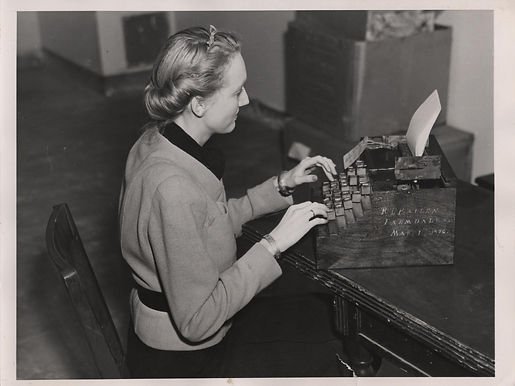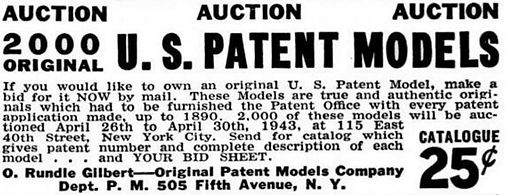
The Allen typewriter represented in the patent model was invented by Kentuckian Robert Thomas Pritchard Allen (1851 - 1930). He was awarded patent no.185,714 on December 26, 1876 for an upstrike typewriter with a five-row keyboard and a traditional looking carriage with platen. It was functionally similar to the Sholes & Glidden that had already been placed into production just two years prior. Allen was also awarded an earlier patent, patent no.171,335, also for a typewriter, which was functionally more like the Malling-Hansen. It is probably fair to state that Mr. Allen was one of the first to realize the immense potential of the new typewriter industry, which he attempted to capitalize on. It’s probably also fair to state that his ideas lacked any innovation.
Neither of Allen’s typewriters were commercially produced but, luckily, the individual patent models were. That’s because when the U.S. patent system was first established, in 1790, each new application was to be accompanied with a small, working model of the actual invention. This requirement was eventually lifted ca.1880, with some exceptions, because the sheer number of models began to occupy too much space (for more information on the history of the U.S. patent office and patent models, I encourage everyone to get a copy of C.O.M.P.U No.66). Though there is no evidence suggesting the survival of Allen’s first patent model, we are very fortunate to have stories and photographs of his second one. Such patent models validate the work of inventors, like Allen, more so than patent paperwork alone can.
R.T.P. Allen Typewriter Patent Model
This 1876 Allen typewriter patent model had been on my radar for a while but, after researching it extensively, I found no record of its existence dated after September 17, 1938. That is when it was last mentioned in an article written by a journalist named George Ross. After then the trail went cold. The fate of this patent model appeared bleak, that is, until new hope manifested itself via eBay. On March 31, 2015 an original New York Times wire photo of the Allen was listed as a Buy-It-Now, which I did.


According to a 1905 Scientific American review, Allen’s 1876 patent model had a closed wooden box frame with half-inch square, wood-block keys. The carriage was made of wood, too, and required both hands to advance it to the next line. The return was driven by a counterweight attached to a cord, similar to the original S&G of 1872-73 except, unlike the S&G, the counterweight was contained within the Allen.. It was all quite crude. So crude that, in 1899, while the Allen was still in the possession of the patent office, a reporter for the Atlanta Constitution inspected it for the first time and described its appearance as a “...worthless block of wood cut in the shape of a staircase.” He also wrongly assumed that it was the “first typewriter ever made in the United States - perhaps the world.” He was not the first, nor would he be the last, to make this erroneous assumption. Again, the Allen was so crudely, almost primitively constructed that one probably couldn't help but assume that it was so much older than it actually was.
Fast-forward to September of 1938 and to the last known whereabouts of the Allen. By then the patent models, all 150,000 of them, had been sold twice. The first time was in 1925 when the Patent Office sold the collection to Sir Henry Solomon Wellcome and then, a second time in 1936, by the estate of Sir Wellcome after his passing. It should be noted that after the Smithsonian was allowed to cherry-pick about 3,500 of the original models, it took the patent office almost 17 years to sell the collection. If not for Sir Wellcome stepping in at the 11th hour the entire collection may have been destroyed.






Between 1948 and now a lot could have happened to the detriment of the 1876 R.T.P Allen patent model, it would be naive to think otherwise. But I am human, and humans are optimists by nature; it’s why we play the lotto despite insurmountable odds. So I am ever-optimistic about the odds of the Allen surfacing someday. I have hope.
In truth, there was one more mention of the Allen in 1960, but it doesn’t count. The Warren Bank and Trust Company used an old stock photo of The Allen in an advertisement to emphasize that the bank uses the “most modern methods” of banking. I find this ad borderline nonsensical.
Maybe you have new info? Maybe you've found the Allen Patent Model? Please email me at Antikey.Chop@gmail.com or call +1 860 729 2252


Two years after the Wellcome estate disposed of the collection, the new stewards allowed journalist George Ross to examine it. Upon review Ross wrote that he had visited “...the most amazing museum in town. One that is not open to the general public for the moment, but one that will be soon, we hope. The museum now clutters the entire thirty-fourth floor of the International Building in the Radio City and belongs to a pair of fabulous gentlemen named Douglas Hertz and Crosby Gaige. The first is a New Jersey Sportsman; the latter is a Broadway producer, country squire, gourmet, engraver, cattle breeder, insect collector and fudge expert.” Ross mentions several patent models in his story including a pretzel bender, a cigar mold and a cash register, and finally, “the first typewriter, patented by R.T.P. Allen in 1876, and made of wood.”
There was an interesting photo published in the Pittsburg Press on September 30, 1938 of a young woman posing with the Allen. Though the photo and corresponding blurb were published about two weeks after the Ross story, the back of the photo is date to June of that year so it precedes Ross’s sighting of the Allen. The woman in the photo is Canadian-born Ann Seranne who, according to the 1940 U.S. census, was living with Crosby Gaige as his secretary. Like Gaige she was also very involved in theater and eventually found fame as a cookbook author and editor of Gourmet magazine.
As for Hertz and Gaige, they never opened that museum. They sold the collection within a couple years and, in 1941, it was shuffled along to yet another owner, Orville Rundle Gilbert. Gilbert was a very well known auctioneer at the time. He bought the collection as in investment with the resolve to create a new collector's market specifically for patent models. To do so he began by auctioning off individual pieces as early as 1943. He also sold some via “premium department store distribution,” which amazingly means that stores like Gimbles stocked patent models on their shelves. Gilbert eventually sold the vast majority of the collection to yet another individual in 1979.
So what of the Allen patent model? Well, the photo I bought is dated to September of 1948 which adds 10 more years through one of the most turbulent decades in modern history. The Allen survived into Gilbert’s years of stewardship, though it doesn’t necessarily prove that it stayed with the collection and that Gilbert actually owned it. The note on the back of the photo states that the Allen was on display at the time to commemorate the 75th anniversary of the typewriter (the 1873 Sholes & Glidden). That’s important because it tells us that whatever institution was displaying the Allen knew that the Allen was of some importance. The photo also indicates that the side of the typewriter is marked with R.T.P. Allen’s name so if anyone were come into possession of this machine they could research it fairly easily, and hopefully appreciate its value. Why the side of the typewriter is dated March 1st is unclear since that is neither the patent filing date nor issue date. Unfortunately, the photo also indicates that the Allen has sustained additional damage. When comparing the 1948 photo to those from ca.1900 it’s evident that the keyboard is in further disrepair and even missing a few more keys.




